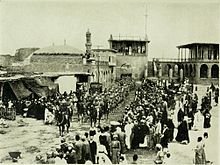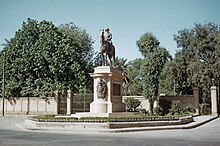Stanley Maude
Sir Stanley Maude | |
|---|---|
First World War
| |
| Awards | Companion of the Order of St Michael and St George Distinguished Service Order Mentioned in dispatches |
Early life
Maude was born in Gibraltar, the youngest son of General Sir Frederick Francis Maude, who had been awarded the Victoria Cross in 1855 during the Crimean War, and of Catherine Mary, née Bisshopp, daughter of Very Reverend Sir George Bisshopp, 9th Baronet, Dean of Lismore. The Maude family claimed descent from Eustace de Montaut, who came over to England during the Norman Conquest.[2]
Maude attended St Michael's School, Aldis House,
Early service
Maude first saw active service in Egypt from March to September 1885, where he was awarded the Egyptian Medal and the Khedive's Egyptian Star. While attending the Staff College, Camberley from 1895 to 1896,[4] he was promoted to captain on 28 August 1895.[5]
He was promoted again, this time to
In May 1901, he was appointed military secretary to the
First World War

Western Front
In World War I, Maude first served in France. He was a staff officer with III Corps when, in October 1914, he was promoted to brigadier-general and given command of the 14th Brigade, part of the 5th Division. He was wounded in April 1915 and returned home to recover. He returned to France in May and, in June, he was promoted to major-general and transferred to command the 33rd Division, then still in training.
Dardanelles
In mid-August, however, Maude was instead given charge of the
Mesopotamia
Maude arrived to catch the end of the British failure at the


Further advances in Mesopotamia were ordered (18 September 1916) by politicians such as
Given reinforcements and more equipment, Maude directed his force in a steady series of victories. Advancing up the Tigris and winning the battles of Mohammed Abdul Hassan, Hai and Dahra in January 1917, recapturing Kut in February 1917, he took Baghdad on 11 March 1917. (He issued the Proclamation of Baghdad on 19 March.) From Baghdad, he launched the Samarrah Offensive and extended his operations to the Euphrates and Diyala rivers.
Death

After a lull over the summer, in November 1917, whilst his forces were engaged at
His body was buried in Baghdad (North Gate) War Cemetery.[15] His initial grave and marker was replaced by a more elaborate structure and then enclosed in a small mausoleum structure on the walls of which is mounted the standard Commonwealth War Graves Commission headstone.[16][17] The epitaph on his CWGC gravestone reads: "'I am the resurrection and the life'. He fought a good fight. He kept the faith."[15] In March 1918 parliament agreed to a request from the King that he grant the sum of £25,000 to his widow.[18]
Memorials

Maude has a memorial stone at
Mount Maude, a peak in the Cascade Range, was named for Frederick Maude by Albert H. Sylvester.[21]
Quotes
- "Our armies do not come into your cities and lands as conquerors or enemies, but as liberators." — Baghdad, March, 1917
References
- ^ a b Davies 1997, p. 92.
- ^ a b Davies 1997, p. 91.
- ^ "No. 25315". The London Gazette. 5 February 1884. p. 532.
- ^ "Sir (Frederick) Stanley Maude - Encyclopedia".
- ^ "No. 26665". The London Gazette. 24 September 1895. p. 5300.
- ^ "No. 27049". The London Gazette. 7 February 1899. p. 793.
- ^ "No. 27353". The London Gazette. 10 September 1901. p. 5927.
- ^ "No. 27359". The London Gazette. 27 September 1901. p. 6303.
- ^ "No. 27318". The London Gazette. 28 May 1901. p. 3639.
- ^ "No. 27364". The London Gazette. 11 October 1901. p. 6641.
- ISBN 1-86066-101-7.
- ^ Liddell Hart 1992, p. 269.
- ^ Woodward 1998, pp. 118–119.
- ^ Woodward 1998, pp. 122, 167.
- ^ a b "Casualty Details: Lieutenant General Maude, Sir Frederick Stanley". Commonwealth War Graves Commission. Retrieved 17 January 2018.
- ^ "Baghdad diary: 'British' cemetery". BBC News. 24 April 2003.
- ^ "#OTD British Empire troops recaptured Baghdad under guidance of Lieut General Maude who is buried at @CWGC Baghdad (North Gate) War Cemetery". CWGC via Twitter. Retrieved 18 January 2018.
- ^ "King's Message [28th February] Read (Hansard, 4 March 1918)". api.parliament.uk.
- Illustrated London News(London, England), Saturday, 19 January 1924; p. 87; Issue 4422
- ^ 'Justice Interrupted', by Elizabeth F. Thompson (Harvard Press, 2013), p. 201.
- ISBN 978-0-918664-00-6.
Bibliography
- ISBN 9780333582619.
- Major General Charles E., Callwell (1920). The Life of Sir Stanley Maude, Lieutenant-General, K.C.B., C.M.G., D.S.O. Constable, Limited.
- Woodward, David R (1998). Field Marshal Sir William Robertson. Westport Connecticut & London: Praeger. ISBN 0-275-95422-6.
- Davies, Frank (1997). Bloody Red Tabs: General Officer Casualties of the Great War 1914–1918. London: Pen & Sword Books. ISBN 978-0-85052-463-5.
- Maude, Frederick Stanley (2012). The Military Papers of Lieutenant-General Sir Frederick Stanley Maude, 1914–1917. History Press for the Army Records Society. ISBN 978-0752486192.
